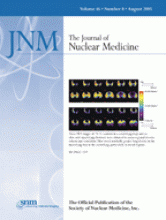Nuclear Cardiology and Correlative Imaging: A Teaching File
J.V. Vitola and D. Delbeke, eds.
New York, NY: Springer-Verlag, 2004, 490 pages, $149
This medium-sized hardcover book consists of 18 chapters mostly about nuclear cardiology, with some about correlative cardiac MRI, echocardiography, and CT. Each chapter begins with a few pages of concise but informative introductory text followed by multiple case presentations. The cases emphasize and clarify some of the points mentioned in the text. Each case is presented as history, findings, discussion, and interpretation. The book contains 143 cases and 396 illustrations, 117 of which are in full color. The sequence of chapters is logical and organized. An introductory chapter is followed by basic science chapters about physics principles, instrumentation, and radiopharmaceuticals—topics that must be understood if one is to fully understand the nuclear cardiology protocols outlined later in the book. Subsequently, the topics of the chapters proceed from the general routine clinical indications for cardiac nuclear imaging in the evaluation of coronary artery disease, myocardial perfusion, and viability to the more specific indications. These include myocardial perfusion imaging in the emergency department, risk stratification for different patient populations, evaluation of the effect of therapy, and evaluation of the heart before surgery. Additionally, there are separate chapters about pitfalls and artifacts in nuclear imaging and evaluation of cardiac function. Subsequent chapters highlight the newer technology of cardiac MRI, CT, stress echocardiography, PET, and PET/CT, with emphasis on the complementary roles of these modalities with the routine, well-established nuclear cardiology studies. Finally, the last chapter highlights and briefly outlines future directions in nuclear cardiology, mostly through case presentations.
The book is interesting and easy to read for both beginners and those with advanced knowledge about nuclear cardiology. For beginners, it is a well-structured, educational book with an interesting combination of background information, teaching cases, and illustrations in each chapter. For the more advanced, it is a comprehensive refresher book. It contains updates on recent developments and investigational radiopharmaceuticals in cardiac nuclear medicine. The references at the end of each chapter are adequate and recent. I particularly enjoyed and learned the most from the chapters on correlative imaging. Noteworthy were the good quality of the illustrations and the usefulness of the discussion on each case presentation. However, I believe that the closing chapter, about future directions in nuclear cardiology, should have had more information about the potential of new advances in nuclear cardiology and more emphasis on cardiac PET and SPECT/CT, instead of just cases. This chapter lacked sufficient enthusiasm about the future of cardiac nuclear medicine.
I highly recommend this book for readers interested in gaining both basic and clinical knowledge of the field of nuclear cardiology and how it integrates with other cardiac imaging modalities. This is an interesting, educational, and easy-to-read book.







